Design
The 6-inch (152 mm)/50 caliber Mark 6 guns were developed around the time of the Spanish–American War. The gun card designates the gun as 46-caliber but the Bureau of Ordnance lists the guns as 50-caliber.
The Mark 6 gun was constructed of gun steel using a tube, jacket, four hoops, a locking ring, and Welin breech block. It was discovered that the pressure curve of the charge and the strength curve of the barrel match exactly along one point of the barrel, because of this the muzzle velocity was reduced from the original 2,800 ft/s (850 m/s) to 2,600 ft/s (790 m/s). With the Mod 1 nickel-steel was used for the tube, two hoops and the locking ring, the gun was also hooped to the muzzle, because of this, the original muzzle velocity was able to be restored. The Mod 2 were Mod 0s with a hoop added to the chase along with a cylindrical liner made from nickel-steel. With these changes the original muzzle velocity was used.
The Mark 8 was similar to the Mark 6 Mod 1 but was constructed entirely out of nickel steel. The Mod 1 had a slightly smaller diameter chamber, but the same volume. The Mod 2 had its rifling grooves increased to 36 from 24 and didn't have the modified chamber of the Mod 1. The Mod 3 had a cylindrical liner made of nickel-steel along with a new chamber design and 36 grooves. Mod 4 used an earlier gun that had its liner replaced with a conical nickel-steel liner along with 36 grooves and the chamber of the Mod 3.
This gun is also unusual for the US Navy where the overall length of the gun barrel, 300.2 in (7,630 mm), is used to measure the caliber of the gun. (i.e.:300.2/6=50) Normally the bore length, 294 in (7,500 mm), would be used and this would actually be a 49 caliber gun. (i.e.:294/6=49)

The 16 inch gun M1919 (406 mm) was a large coastal artillery piece installed to defend the United States' major seaports between 1920 and 1946. It was operated by the United States Army Coast Artillery Corps. Only a small number were produced and only seven were mounted; in 1922 and 1940 the US Navy surplussed a number of their own 16-inch/50 guns, which were mated to modified M1919 carriages and filled the need for additional weapons.

The 4″/50-caliber gun was the standard low-angle, quick-firing gun for United States, first appearing on the monitor Arkansas and then used on "Flush Deck" destroyers through World War I and the 1920s. It was also the standard deck gun on S-class submarines, and was used to rearm numerous submarines built with 3-inch (76 mm) guns early in World War II. United States naval gun terminology indicates the gun fired a projectile 4 inches in diameter, and the barrel was 50 caliber. 4x50 meant that the barrel was 200 inches long, or 16 feet long.

The 14-inch/45-caliber gun,, whose variations were known initially as the Mark 1, 2, 3, and 5, and, when upgraded in the 1930s, were redesignated as the Mark 8, 9, 10, and 12. They were the first 14-inch (356 mm) guns to be employed by the United States Navy. The 14-inch/45-caliber guns were installed as the primary armament aboard all of the United States Navy's New York-class, Nevada-class, and Pennsylvania-class battleships. The gun also saw service in the British Royal Navy, where it was designated BL 14-inch gun Mk II.

The 16"/50 caliber Mark 2 gun and the near-identical Mark 3 were guns originally designed and built for the United States Navy as the main armament for the South Dakota-class battleships and Lexington-class battlecruisers. The successors to the 16"/45 caliber gun Mark I gun, they were at the time among the heaviest guns built for use as naval artillery.
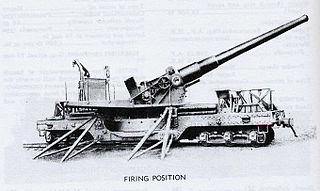
The 8-inch Navy gun Mk.VI M3A2 on railway mount M1A1 was a World War II improved replacement for the World War I-era 8-inch M1888 gun and was used by the US Army's Coast Artillery Corps in US harbor defenses. The guns were also mounted in fixed emplacements on the barbette carriage M1A1. These guns were US Navy surplus 8"/45 caliber guns from battleships scrapped under the 1922 Washington Naval Treaty. Mark VI was the Navy designation. The Army designation for this gun was "8-inch Navy gun Mk.VI M3A2".
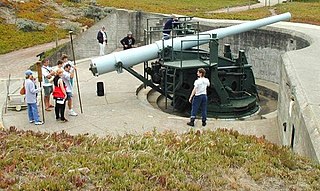
The 6-inch gun M1897 (152 mm) and its variants the M1900, M1903, M1905, M1908, and M1 were coastal artillery pieces installed to defend major American seaports between 1897 and 1945. For most of their history they were operated by the United States Army Coast Artillery Corps. They were installed on disappearing carriages or pedestal mountings, and during World War II many were remounted on shielded barbette carriages. Most of the weapons not in the Philippines were scrapped within a few years after World War II.
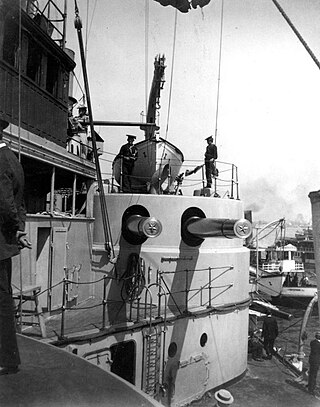
The 8"/35 caliber gun Mark 3 and Mark 4 were used for the main batteries of the United States Navy's first armored cruisers and the secondary batteries for their first battleships, the Indiana-class. The 8"/40 caliber gun Mark 5 initially armed the Pennsylvania-class armored cruisers.
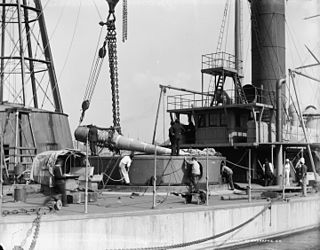
The 10"/31 caliber gun Mark 1 Mod 1 and the 10"/35 caliber gun Mark 1 Mod 2 were both used for the primary batteries of the United States Navy's Amphitrite-class monitor Miantonomoh. The 10"/30 caliber gun Mark 2 was used as main armament on the remaining Amphitrite-class monitors, the monitor Monterey, and the armored cruiser Maine.

The 12"/35 caliber gun were used for the primary batteries of the United States Navy's "New Navy" monitors Puritan and Monterey and the battleships Texas and Iowa.

The 8"/45 caliber Mark 6 gun were used for the secondary batteries of the United States Navy's last pre-dreadnought battleships and refitted in older armored cruisers main batteries.

The 10"/40 caliber gun Mark 3 was used for the main batteries of the United States Navy's last generation of armored cruisers, the Tennessee-class. The Mark 3s were the last, and most powerful, 10-inch (254 mm) guns built for the US Navy.

The 7"/44 caliber gun Mark 1 and 7"/45 caliber gun Mark 2 were used for the secondary batteries of the United States Navy's last generation of pre-dreadnought battleships, the Connecticut-class and Mississippi-class. The 7-inch (178 mm) caliber was considered, at the time, to be the largest caliber weapon suitable as a rapid-fire secondary gun because its shells were the heaviest that one man could handle alone.

The 6"/30 caliber gun Mark 1 were used for the primary battery of the United States Navy's dispatch vessel Dolphin with the Mark 2 being used in the secondary batteries for its "New Navy" protected cruisers Atlanta, Chicago, and Boston and the Mark 3 used for the primary and secondary batteries in the succeeding early protected cruisers in addition to secondary batteries in the "Second Class Battleships" Maine and Texas.

The 6"/40 caliber gun Mark 4 were used for the secondary batteries of the United States Navy's Indiana-class and Illinois-class battleships. They were also used as the main battery on the Cincinnati-class protected cruisers.
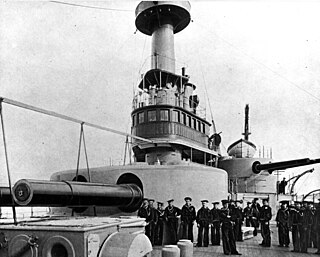
The 13"/35 caliber gun Mark 1 was used for the primary batteries on eight of the first nine battleships in the United States Navy, Indiana-class, Kearsarge-class and Illinois-class; USS Iowa (BB-4) used the 12-inch (305 mm)/35 caliber gun.

The 4″/40 caliber gun was used for the secondary batteries on the United States Navy's battleship Iowa, Columbia-class protected cruisers, and the armored cruiser New York, and was the primary batteries on the gunboats Nashville, Wilmington, and Helena.
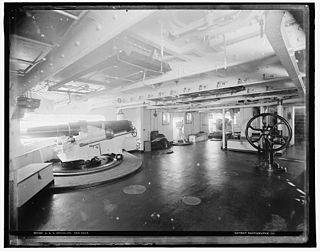
The 5″/40 caliber gun were used in the secondary batteries of the United States Navy's early battleships, armored cruisers, protected cruisers, unprotected cruisers, and auxiliary cruisers.

The 5"/50 caliber gun was the first long barrel 5-inch (127 mm) gun of the United States Navy and was used in the secondary batteries of the early Delaware-class dreadnought battleships, various protected cruisers, and scout cruisers. They were also refitted in the secondary batteries of the armored cruiser New York and the New Orleans-class protected cruisers. They were later used on cargo ships, store ships and unclassified auxiliaries during World War II as well as in emergency coastal defense batteries.
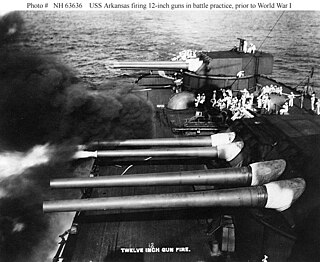
The 12"/50 caliber Mark 7 gun was a United States Navy's naval gun that first entered service in 1912. Initially designed for use with the Wyoming class of dreadnought battleships, the Mark 7 also armed the Argentine Navy's Rivadavia-class battleships.

The 16"/45 caliber gun was used for the main batteries of the last class of Standard-type battleships for the United States Navy, the Colorado-class. These guns promised twice the muzzle energy over the Mark 7 12-inch/50 caliber guns of the Wyoming-class battleship and a 50% increase over the 14-inch/45 caliber guns of the New York-class, Nevada-class, and Pennsylvania-class battleships.




















